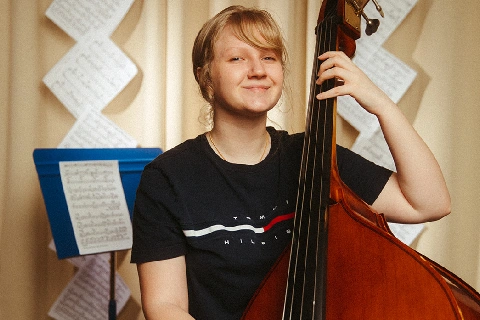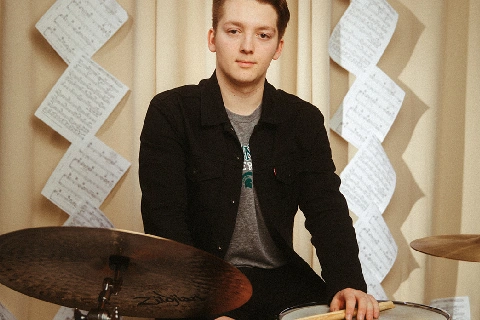The following are guidelines to help you have a successful, rewarding, experience in learning the trumpet and trombone. We have arrived at these conclusions after many years of teaching hundreds of students.
1. Starting at the Right Age
Trumpet students should wait until at least 8 years old and trombone students, due to the size of the instruments should probably wait until about 10 years old.
2. Be Aware of the Quality of the Instrument
Most students rent the first trumpet or trombone. There are lots of cheap instruments that do not play well, so be very careful when purchasing an instrument. Most rental outlets will carry good brands, but without proper cleaning and maintenance by the player all instruments will develop problems.
A few brands that make good instruments for beginning students are Conn, Bach, Jupiter, and Yamaha. See here for instrument rental information.
3. Performing Builds Confidence
You don’t have to be a great musician to perform. A student that has a few months of dedicated practice should be able to play at least one song from start to finish. It doesn’t have to be a difficult piece. The experience of performing builds the student’s confidence and creates the desire to tackle even more challenging material. A well-rounded musical program will include performance opportunities in the way of showcases, outdoor concerts, and other occasional events throughout the year.
4. For the Best Results, Choose Private Instruction
Group lessons work well for beginners to get exposure to an instrument, and to let parents know the desire level and practice habits of the child. Also school band, orchestra, and seminar situations obviously require a group. Most of these situations do not provide actual instruction on the instrument unless it is a seminar or workshop. Band leaders and school teachers help as much as they can but they are mainly there to get the group to play together and do not have time to instruct the individual players.
When actually learning how to play an instrument, private lessons are undeniably superior since the student has the undivided attention of the instructor. Also, the student can progress at his or her own pace, with extra time being spent on the individual student’s desires and weaknesses. The pressure of having to keep up with other students or the frustration of having to wait for other students who may not have even practiced their lesson can be very discouraging. With private lessons, progress is expedited and the student gets a customized lesson providing him with the knowledge he wants and needs.
5. Be Aware of the Quality of the Teacher
Of course there are many very good musicians that never studied their instrument formally. Some have learned by ear or picked up knowledge from friends along the way. But to be able to properly teach someone else, there should be a certain level of formal education that has been achieved. This way the student knows that the instructor has taken the time to train in the field that he is teaching. Not only do most of our instructors have university, college, or music conservatory degrees on their instrument, but they also perform regularly on stages ranging from local to national.
When teaching children, knowing how to relate at their level and keep them motivated is just as important as being knowledgeable on the instrument. A good school will choose from a pool of many potential instructors, saving you the time and trouble of searching for a well qualified, professional teacher. In our music academy, the lessons are not just a hobby or sideline for the teacher but a career and responsibility, which are taken very seriously.
6. Learning in an Appropriate Setting
Not only is it necessary to have a qualified teacher, but also having an optimal learning environment is very important. With ½ to 1 full hour of lesson time per week, a professional school environment can produce better results since all of the time is focused on learning music and all of the tools and materials necessary are already in place. Although a traveling teacher sounds like a good idea for convenience sake, the reality is that there are distractions like phones, pets, or other kids which sometimes make concentrating difficult. It is also common during a lesson to have a situation come up where a specific problem needs to be addressed. With a complete library of musical materials and references readily available a teacher teaching at an academy can address the problem immediately rather than putting it off until the next week. Hearing peers who are at different levels of progress can also inspire students.
7. Purchase a Chromatic Tuner ASAP
Whether you are playing solo, or especially with a group, you will need to keep your instrument tuned. The easiest way to check to see if you are in tune is by using a chromatic electronic tuner. Other ways to check to see if you are in tune are:
- Tune to a tuning fork
- Tune to a pitch pipe
- Let your teacher tune your instrument.
A chromatic tuner will usually cost between $15 and $30 depending on the brand, and will save you tons of time and frustration tuning your instrument.
8. Purchase a Metronome (or Drum Machine)
A metronome is just a device that makes a clicking sound. You set the speed of the click to the recommended speed or if there is no recommended speed, you set the speed to a point that you are able to play your song or exercise that you are practicing. A drum machine is really just a deluxe metronome with cooler sounds that costs more money. It can be used for the same purpose. If you have an electronic keyboard that has programmed rhythms, that can work instead of a metronome too.
9. Making Practice Easier
As in all things, improvement in music takes practice. One of the main problems with studying an instrument is the drudgery of practicing and the fight between students and parents that ensues. How to make practice easier:
- Time – Set the same time each day to practice so that it becomes a routine or habit. This is especially good for children but works for adults too. The earlier in the day that this happens the more likely the practice will not be put off until tomorrow.
- Repetition – This method works quite well when setting practice schedules for beginners. For a younger person 20 or 30 minutes may seem like an eternity. Therefore instead of a time frame we suggest repetition. For example do this song 4 times each day and this scale 5 times a day. Then the clock is not the enemy, as soon as the work gets done (correctly) the child is free.
- Rewards – Children respond well to rewards. As parents we can reward the child by saying when your practice is complete you can have x number of minutes on the PlayStation or other coveted activity. As teachers we sometimes will use stickers or more importantly, the praise of the teacher “Excellent job, keep it up” can be the best reward. For adults, usually a nice cup of java or other beverage will make the experience a little more rewarding.
In conclusion, playing a musical instrument should be an enjoyable experience, not a stress inducer. There will be times, usually at the end of the term for children, or a big project at work for adults, when the student will not able to practice. The goal is to learn at your own pace, not at the pace your friend or idol learned. As long as you know that you want to learn the instrument and that you are giving it your attention as much as is realistically possible, then you are being successful. The fun is the journey.





